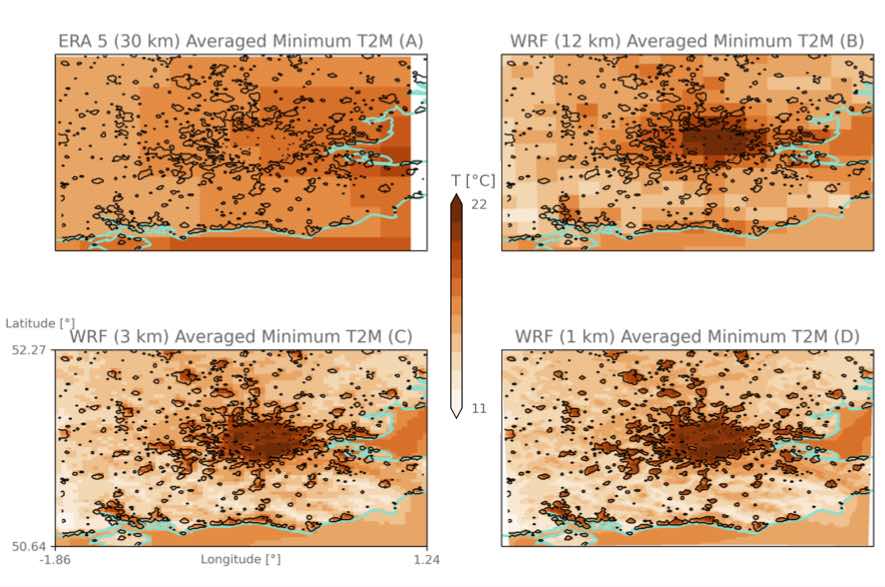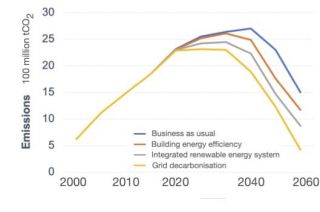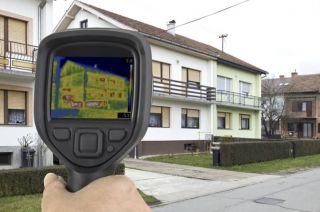
www.buildingsandcities.org/insights/commentaries/hi-res-model.html
Why High-Resolution Climate Modelling Matters: Cities and Health
By Clare Heaviside (University College London - UCL), Jonathon Taylor (UCL & Tampere U), Oscar Brousse (UCL), Charles Simpson (UCL)
Current and projected temperatures simulated by global climate models are typically output at a coarse resolution of 30-100 km. This is unhelpful for identifying climate-related public health risks in cities. New mapping is needed at higher resolution to better characterize hazards and prepare location-specific adaptation plans.
The range of negative health impacts of exposure to heat is widely researched and acknowledged (Basu, 2009). In the UK, around 2,000 deaths per year are attributed to heat (Hajat et al, 2014). Heat exposure is of particular concern due to: i) global observations of rising temperatures; ii) more frequent heatwaves associated with climate change, and iii) rising urban populations, who are exposed to the urban heat island (UHI) effect (Field et al., 2012; Melorose et al., 2015).
Risk assessments use relationships between ambient temperature and health outcomes such as risk of hospitalization or mortality to estimate health burdens for specific populations, e.g. the fraction of all-cause mortality which can be attributed to heat. By using projected temperatures derived from climate models, it is also possible to assess the potential change in health impacts we might expect in future (Gasparrini et al., 2017). These risk estimates are informative to policy makers for planning health and social care provisions, particularly in anticipation of heatwave events (Public Health England, 2015), or for designing mitigation and adaptation actions to protect health in future.
One source of uncertainty in climate change risk assessment relates to the type and resolution of exposure (temperature) data input to the risk assessment model, for example global-scale climate models are not designed to capture local or regional scale features, due to their coarse resolution (~30-100 km) (Goodess et al., 2021). This has particular importance for the UHI, because global climate model outputs do not represent the urban impact on the local climate, and therefore underestimate population heat exposure, and related public health impacts.
One solution is to use higher resolution climate or
meteorological modelling. This can be computationally expensive and difficult
to set up and run over large areas, but it can be effectively employed for
specific cities or regions to better represent temperatures across urban areas
(e.g. London, Figure 1). Previous simulations using a 1x1 km resolution
meteorological model for Birmingham in the UK estimated that the UHI
contributes up to 40% of heat-related mortality over a summer, (Macintyre & Heaviside, 2019) and up to 50% during a
heatwave (Heaviside et al., 2016). Estimates of heat-related
risks in the future without such highly resolved data might therefore be
underestimated by a half. 
Action
Climate change risk assessment models are an important component of local adaptation strategies. They need to be used by policy makers, strategists, planners and stakeholders to assess potential future impacts of climate change, and to develop actions that will reduce risks. Quantitative estimates of societal risk are essential for long term planning, but local and city scale analysis provides necessary detail to reveal the extent to which a population is exposed or is vulnerable to the effects of heat. This vulnerability depends on multiple factors, including local climate, geography, housing and social and economic factors (Macintyre et al., 2018; Taylor et al., 2018).
Additional city-scale modelling and spatial analysis (based
on high-resolution climate modelling) must add demographic data to 1) identify
vulnerable population groups or geographical areas; 2) investigate the impacts
of potential city-level and neighbourhood-level interventions, and 3) reduce health
inequalities and the potential for unintended consequences from adaptation
measures at local scales. This will enable strategists, planners and others in central
and local government to more effectively prepare appropriate adaptation
responses and focus efforts where they can have the greatest benefit to health
and wellbeing, and to society as a whole.
Acknowledgements
CH is supported by a NERC fellowship (NE/R01440X/1) and acknowledges funding from the Wellcome Trust HEROIC project (216035/Z/19/Z), which funds OB and CS.
References
Basu, R. (2009). High ambient temperature and mortality: A review of epidemiologic studies from 2001 to 2008. Environmental Health: A Global Access Science Source, 8(1). https://doi.org/10.1186/1476-069X-8-40
Field, C. B., Barros, V. R., Stocker, T. F., Qin, D., Dokken, D. J., Ebi, K. L., … Midgley, P. M. (2012). Managing the Risks of Extreme Events and Disasters to Advance Climate Change Adaptation. A Special Report of Working Groups I and II of the Intergovernmental Panel on Climate Change, 1-594. https://doi.org/10.1017/CBO9781139177245
Gasparrini, A., Guo, Y., Sera, F., Vicedo-Cabrera, A. M., Huber, V., Tong, S., … Armstrong, B. (2017). Projections of temperature-related excess mortality under climate change scenarios. The Lancet Planetary Health, 1(9), e360-e367. https://doi.org/10.1016/S2542-5196(17)30156-0
Goodess, C., Berk, S., Ratna, S. B., Brousse, O., Davies, M., Heaviside, C., Moore, C. & Pineo, H. (2021). Climate change projections for sustainable and healthy cities. Buildings and Cities, 2(1), 812-836. https://doi.org/10.5334/bc.111
Hajat, S., Vardoulakis, S., Heaviside, C., & Eggen, B. (2014). Climate change effects on human health: Projections of temperature-related mortality for the UK during the 2020s, 2050s and 2080s. Journal of Epidemiology and Community Health, 68(7), 641-648. https://doi.org/10.1136/jech-2013-202449
Heaviside, C., Vardoulakis, S., & Cai, X.-M. (2016). Attribution of mortality to the urban heat island during heatwaves in the West Midlands, UK. Environmental Health: A Global Access Science Source, 15. https://doi.org/10.1186/s12940-016-0100-9
Macintyre, H. L., & Heaviside, C. (2019). Potential benefits of cool roofs in reducing heat-related mortality during heatwaves in a European city. Environment International, 127, 430-441. https://doi.org/10.1016/J.ENVINT.2019.02.065
Macintyre, H. L., Heaviside, C., Taylor, J., Picetti, R., Symonds, P., Cai, X.-M., & Vardoulakis, S. (2018). Assessing urban population vulnerability and environmental risks across an urban area during heatwaves - Implications for health protection. Science of the Total Environment, 610-611, 678-690. https://doi.org/10.1016/j.scitotenv.2017.08.062
Melorose, J., Perroy, R., & Careas, S. (2015). World population prospects. United Nations, 1(6042), 587-592. https://doi.org/10.1017/CBO9781107415324.004
Taylor, J., Symonds, P., Wilkinson, P., Heaviside, C., Macintyre, H., Davies, M., … Hutchinson, E. (2018). Estimating the influence of housing energy efficiency and overheating adaptations on heat-related mortality in the West Midlands, UK. Atmosphere, 9(5). https://doi.org/10.3390/atmos9050190
Latest Peer-Reviewed Journal Content
A framework for 1.5°C-aligned GHG budgets in architecture
G Betti, I Spaar, D Bachmann, A Jerosch-Herold, E Kühner, R Yang, K Avhad & S Sinning
Net zero retrofit of the building stock [editorial]
D Godoy-Shimizu & P Steadman
Co-learning in living labs: nurturing civic agency and resilience
A Belfield
The importance of multi-roles and code-switching in living labs
H Noller & A Tarik
Researchers’ shifting roles in living labs for knowledge co-production
C-C Dobre & G Faldi
Increasing civic resilience in urban living labs: city authorities’ roles
E Alatalo, M Laine & M Kyrönviita
Co-curation as civic practice in community engagement
Z Li, M Sunikka-Blank, R Purohit & F Samuel
Preserving buildings: emission reductions from circular economy strategies in Austria
N Alaux, V Kulmer, J Vogel & A Passer
Urban living labs: relationality between institutions and local circularity
P Palo, M Adelfio, J Lundin & E Brandão
Living labs: epistemic modelling, temporariness and land value
J Clossick, T Khonsari & U Steven
Co-creating interventions to prevent mosquito-borne disease transmission in hospitals
O Sloan Wood, E Lupenza, D M Agnello, J B Knudsen, M Msellem, K L Schiøler & F Saleh
Circularity at the neighbourhood scale: co-creative living lab lessons
J Honsa, A Versele, T Van de Kerckhove & C Piccardo
Positive energy districts and energy communities: how living labs create value
E Malakhatka, O Shafqat, A Sandoff & L Thuvander
Built environment governance and professionalism: the end of laissez-faire (again)
S Foxell
Co-creating justice in housing energy transitions through energy living labs
D Ricci, C Leiwakabessy, S van Wieringen, P de Koning & T Konstantinou
HVAC characterisation of existing Canadian buildings for decarbonisation retrofit identification
J Adebisi & J J McArthur
Simulation and the building performance gap [editorial]
M Donn
Developing criteria for effective building-sector commitments in nationally determined contributions
P Graham, K McFarlane & M Taheri
Reimagining circularity: actions for optimising the use of existing buildings
R Lundgren, R Kyrö, S Toivonen & L Tähtinen
Effective interdisciplinary stakeholder engagement in net zero building design
S Vakeva-Baird, F Tahmasebi, JJ Williams & D Mumovic
Metrics for building component disassembly potential: a practical framework
H Järvelä, A Lehto, T Pirilä & M Kuittinen
The unfitness of dwellings: why spatial and conceptual boundaries matter
E Nisonen, D Milián Bernal & S Pelsmakers
Environmental variables and air quality: implications for planning and public health
H Itzhak-Ben-Shalom, T Saroglou, V Multanen, A Vanunu, A Karnieli, D Katoshevski, N Davidovitch & I A Meir
Exploring diverse drivers behind hybrid heating solutions
S Kilpeläinen, S Pelsmakers, R Castaño-Rosa & M-S Miettinen
Urban rooms and the expanded ecology of urban living labs
E Akbil & C Butterworth
Living with extreme heat: perceptions and experiences
L King & C Demski
A systemic decision-making model for energy retrofits
C Schünemann, M Dshemuchadse & S Scherbaum
Modelling site-specific outdoor temperature for buildings in urban environments
K Cebrat, J Narożny, M Baborska-Narożny & M Smektała
Understanding shading through home-use experience, measurement and modelling
M Baborska-Narożny, K Bandurski, & M Grudzińska
Building performance simulation for sensemaking in architectural pedagogy
M Bohm
Beyond the building: governance challenges in social housing retrofit
H Charles
Heat stress in social housing districts: tree cover–built form interaction
C Lopez-Ordoñez, E Garcia-Nevado, H Coch & M Morganti
An observational analysis of shade-related pedestrian activity
M Levenson, D Pearlmutter & O Aleksandrowicz
Learning to sail a building: a people-first approach to retrofit
B Bordass, R Pender, K Steele & A Graham
Market transformations: gas conversion as a blueprint for net zero retrofit
A Gillich
Resistance against zero-emission neighbourhood infrastructuring: key lessons from Norway
T Berker & R Woods
Megatrends and weak signals shaping future real estate
S Toivonen
A strategic niche management framework to scale deep energy retrofits
T H King & M Jemtrud
Generative AI: reconfiguring supervision and doctoral research
P Boyd & D Harding
Exploring interactions between shading and view using visual difference prediction
S Wasilewski & M Andersen
How urban green infrastructure contributes to carbon neutrality [briefing note]
R Hautamäki, L Kulmala, M Ariluoma & L Järvi
Implementing and operating net zero buildings in South Africa
R Terblanche, C May & J Steward
Quantifying inter-dwelling air exchanges during fan pressurisation tests
D Glew, F Thomas, D Miles-Shenton & J Parker
Western Asian and Northern African residential building stocks: archetype analysis
S Akin, A Eghbali, C Nwagwu & E Hertwich
Join Our Community

The most important part of any journal is our people – readers, authors, reviewers, editorial board members and editors. You are cordially invited to join our community by joining our mailing list. We send out occasional emails about the journal – calls for papers, special issues, events and more.
We will not share your email with third parties. Read more



Latest Commentaries
COP30 Report
Matti Kuittinen (Aalto University) reflects on his experience of attending the 2025 UN Conference of the Parties in Belém, Brazil. The roadmaps and commitments failed to deliver the objectives of the 2025 Paris Agreement. However, 2 countries - Japan and Senegal - announced they are creating roadmaps to decarbonise their buildings. An international group of government ministers put housing on the agenda - specifying the need for reduced carbon and energy use along with affordability, quality and climate resilience.
Building-Related Research: New Context, New Challenges
Raymond J. Cole (University of British Columbia) reflects on the key challenges raised in the 34 commissioned essays for Buildings & Cities 5th anniversary. Not only are key research issues identified, but the consequences of changing contexts for conducting research and tailoring its influence on society are highlighted as key areas of action.